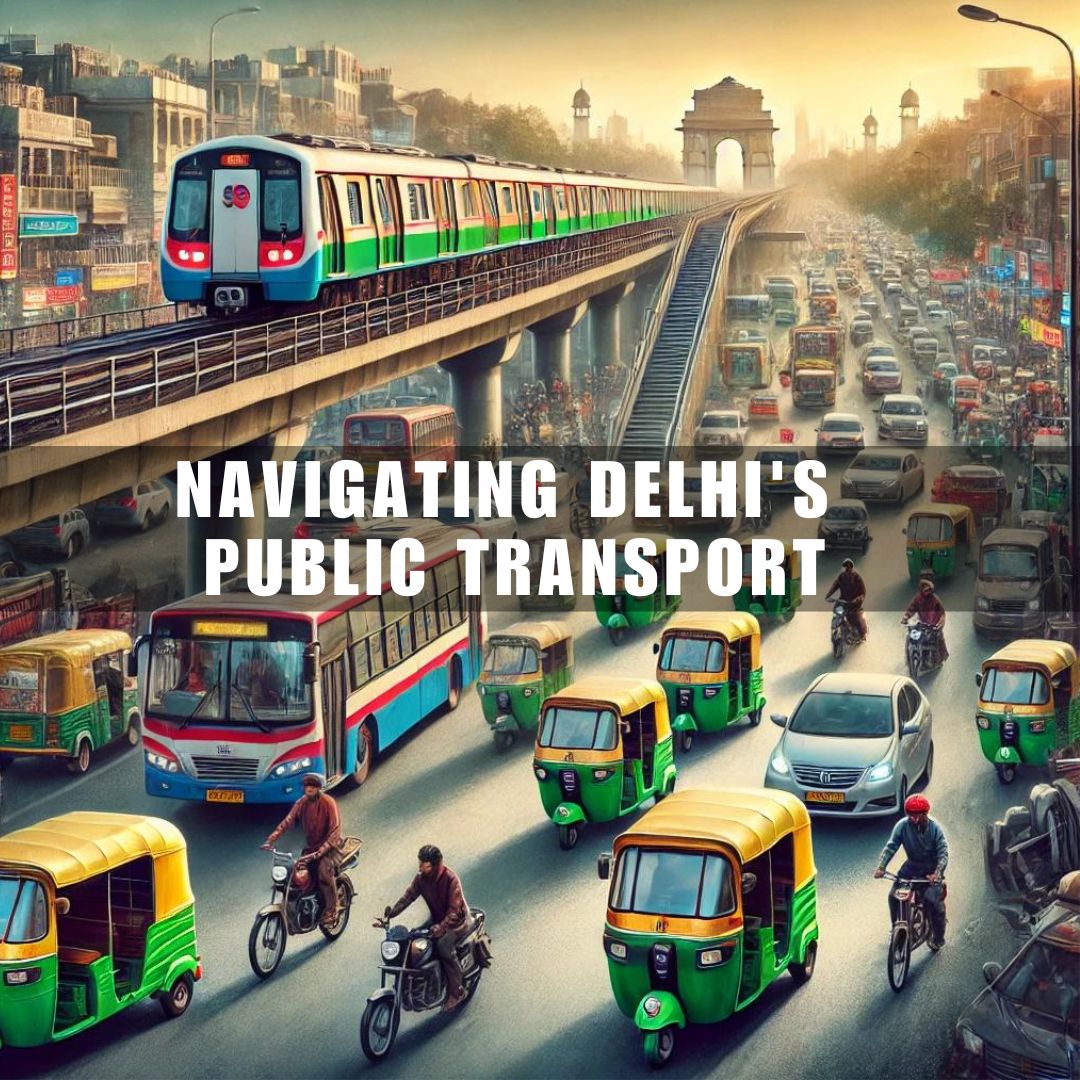Navigating Delhi's Public Transport: A Visual Guide
Delhi, the bustling capital of India, is known for its historical monuments, vibrant culture, and, of course, its vast public transport system. Navigating Delhi can be challenging for newcomers, but understanding the city’s public transport system will make getting around much easier. With a bit of planning and awareness, you can efficiently explore Delhi while saving time and money. This guide will help you understand how to use Delhi’s public transportation, including the metro, buses, auto-rickshaws, and cycle-rickshaws, with ease.
The Delhi Metro – A Convenient Way to Travel
The Delhi Metro is the backbone of the city’s public transport network. Clean, fast, and reliable, the metro is the most popular option for locals and tourists alike.
How to Use the Delhi Metro:
Get a Metro Card: To avoid standing in long ticket lines, purchase a Delhi Metro card. It’s a rechargeable smart card that you can use at any metro station.
Download the Metro Map: Delhi Metro has a well-connected network with multiple lines. Download a metro map or use the Delhi Metro app to understand which line you need to take.
Travel Comfortably: The metro trains are air-conditioned, making it comfortable even during Delhi’s hot summers.
Women-Only Coaches: The first coach of every train is reserved for women. This is a great option for female travelers looking for a more comfortable ride.
Pro Tip: Avoid rush hours (8:00–10:30 AM and 5:00–7:30 PM) when the metro can be very crowded.
Delhi’s Bus System – The Affordable Option
Delhi’s buses are the most affordable way to travel across the city, but they can be a bit confusing for first-timers. The city operates two main types of buses: Delhi Transport Corporation (DTC) buses and Cluster buses (which are orange in color). DTC buses are either air-conditioned or non-air-conditioned, while the Cluster buses are slightly newer.
Using Delhi Buses:
Bus Numbers and Routes: Each bus route is numbered, and you can check routes online using apps like Ridlr or Google Maps. Many bus stops also display route numbers.
Bus Passes: Regular commuters can buy a bus pass for unlimited travel on DTC buses for a day or a month, depending on your need.
Tickets: If you don’t have a pass, you can buy a ticket from the conductor on board. Remember to carry small change, as conductors often don’t have the ability to break large bills.
Pro Tip: Buses can get crowded, especially during peak hours. If you’re new to the system, try using them during off-peak times.
Auto-Rickshaws – The Fast and Flexible Option
Auto-rickshaws are three-wheeled vehicles that are perfect for shorter trips or when you need a ride to places that aren’t directly accessible by metro or bus. They are quick, flexible, and you’ll find them everywhere in the city.
Things to Know About Auto-Rickshaws:
Meters and Fares: Auto-rickshaws are required to run on meters, but not all drivers follow this rule. Always ask the driver to use the meter or negotiate a fare before starting the journey.
Use Ride-Hailing Apps: You can book auto-rickshaws through apps like Ola or Uber. These apps show the estimated fare upfront, ensuring you aren’t overcharged.
Bargaining: If the driver doesn’t want to use the meter, be prepared to bargain for the fare. Knowing the approximate distance of your trip can help you get a fair price.
Pro Tip: Avoid auto-rickshaws parked near tourist attractions, as they may charge higher fares. Walk a little away from these areas to find a reasonably priced ride.
Cycle-Rickshaws – For Short, Scenic Rides
If you’re traveling within Old Delhi or other smaller, congested areas, a cycle-rickshaw is a pleasant and environmentally friendly option. These human-powered vehicles are ideal for short, slow-paced journeys.
Using Cycle-Rickshaws:
Best for Short Distances: Cycle-rickshaws are slow, so they’re best for covering short distances, such as going from one monument to another within a small area.
Fare Negotiation: There are no fixed fares for cycle-rickshaws, so it’s important to negotiate the price before hopping on.
Pro Tip: While cycle-rickshaws offer a unique way to experience Delhi’s streets, they are not suitable for long distances or during hot afternoons.
Ride-Sharing Apps – A Convenient Alternative
In recent years, ride-hailing apps like Ola and Uber have become increasingly popular in Delhi. These apps offer a convenient and stress-free way to get around the city without needing to worry about cash or language barriers.
Advantages of Ride-Sharing Apps:
Ease of Use: Book rides from anywhere in the city using your smartphone. The app calculates the fare, and you can pay through cash or online payment options.
Safety: Both Ola and Uber offer safety features like GPS tracking and emergency buttons, making them a safer option for solo travelers, especially at night.
Different Vehicle Options: You can choose from a range of vehicles, from economical small cars to larger taxis, depending on your budget and comfort.
Pro Tip: Surge pricing can occur during rush hours or bad weather, so check the fare before booking.
Taxis – A Traditional Option
Although ride-hailing apps have reduced the need for traditional taxis, you can still find black-and-yellow taxis in Delhi. These are available at railway stations, airports, and major tourist spots.
Using Taxis:
Meter or Fixed Fare: Always ask the driver to turn on the meter or agree on a fixed price beforehand.
Radio Taxis: Alternatively, you can book a radio taxi from services like Meru Cabs or Easy Cabs by calling their customer service or through their mobile app.
Pro Tip: Taxis are more expensive than other forms of public transport, so use them when comfort or urgency is a priority.
E-Rickshaws – A Green Choice
E-rickshaws are electric, battery-powered vehicles that have become popular in Delhi for short-distance travel, especially around metro stations and busy markets. They are cheap and environmentally friendly.
How to Use E-Rickshaws:
Fixed Routes: E-rickshaws often operate on fixed routes, connecting people from metro stations to nearby residential areas or markets.
Fare: The fare is usually low and fixed, but it’s always good to confirm the price with the driver before getting in.
Pro Tip: E-rickshaws are perfect for short trips, but don’t expect a fast ride. They’re slower than auto-rickshaws but quieter and more eco-friendly.
Planning Your Trip – Smart Tips for Navigating Delhi
Use Apps: Apps like Google Maps, Delhi Metro Rail, Ola, and Uber are essential for navigating the city. They give real-time updates on traffic and public transport schedules.
Avoid Peak Hours: Delhi’s roads and public transport can get incredibly crowded during peak hours, typically between 8:00–10:30 AM and 5:00–7:30 PM. Try to plan your journeys outside of these times for a more comfortable experience.
Keep Change Handy: Whether you’re paying for bus tickets or bargaining with auto drivers, small denomination notes are helpful.
Be Aware of Safety: Delhi is a large city, so staying alert and cautious is important. Avoid isolated areas after dark and prefer well-lit, busy streets.
Safety Tips for Public Transport
Women Travelers: If you’re a female traveler, consider using the women-only compartments in the metro or booking rides via apps for added safety.
Beware of Pickpockets: Crowded places like metro stations or buses can attract pickpockets, so keep your belongings secure.
Keep a Map Handy: Even though Google Maps is helpful, it’s always a good idea to carry a small city map, especially if your phone’s battery runs low.




